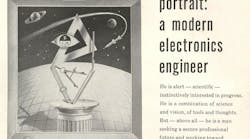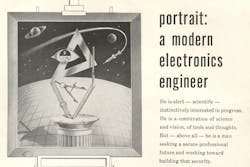This morning, I cleared up a question from our Production Editor about an equation in a contributed article. It was simple: there was a space missing between a numerical value and the dimensional unit it referred to, which was a millisiemens (mS), the unit of transconductance. (Here’s what the IEEE says about spelling and abbreviating common units.)
Naturally, I had to add a sentence to my email about the Siemens replacing the mho. Which sent me down memory lane back to the IRE show back in 1962, in the old Coliseum, up on Columbus Circle.
50-odd years ago, being a double-E was all about slide rules, imaginary rocketships, and being male.
That was the conference at which it was announced that the Institute of Radio Engineers (IRE) and the American Institute of Electrical and Electronic Engineers (AIEE) would, come next January 1, be merged into the afore mentioned Institute of Electrical and Electronics Engineers (IEEE). That was also where the announcement was made that, henceforth, the U.S. professional societies would follow the guidelines of the Bureau International des Poids et Mesures when writing about scientific units. The old-fashioned unit, cycles/second, which was helpful in solving equations by dimensional analysis, became the Hertz, which required an extra element in the equation. At the same time the amusing mho, or Ohm, spelled backward, became the Siemens, named after the hitherto neglected Werner von Siemens. Siemens was the prototype serial entrepreneur, who more or less invented the start-up, based on inventions ranging from a telegraph with a dial that pointed to letters of the alphabet to electrically-driven mass transit and made successes out of most of them.
That 1962 conference and tradeshow was my first experience with engineering conferences. I was a freshman at Newark College of Engineering, and sensed some of the circuits EEs and the power EEs, and the internationalization of the profession implicit in the standardization of units. Some later IEEE shows were watershed events personally, and with respect to the industry. I interviewed for my first professional job at the one in 1966, and I remember 1977, when TI introduced the MicroMouse contest, marking, for me, at least, the evolution of the microcontroller from a way of controlling industrial machinery to something that would become ubiquitous.

